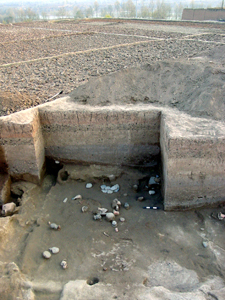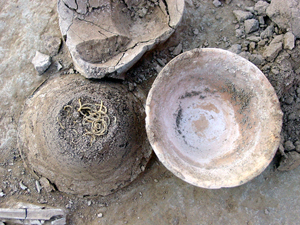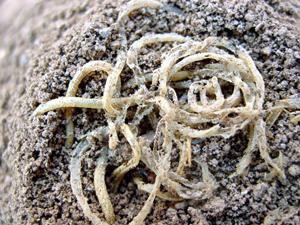The earliest Chinese noodles from Lajia
The Lajia site again gives a big surprise to the public. A paper “Millet noodles in Late Neolithic, China” published in Nature (vol.437: p.967-968) confirmed that the noodle-like remains in a ceramic bowl found on the floor of house F20 at the site were indeed noodles.

During the excavation in 2002, archaeologists unearthed the red fine clay bowl decorated with basket pattern on the floor of F20 with its bottom up. When carefully taking up the bowl, archaeologists found the earth under it was in the shape of a block of noodles. Though very brittle, the shape of the noodles could still be clearly recognized. After taking several photographs, archaeologists put the bowl back and took the bowl together with the remains in it to their lab in Beijing. This intriguing discovery was introduced to the public at the end of 2002. Yet since no scientific analysis was made on the remains, the discovery had not caught much attention of the scholars and public.
In 2004, Professor Lu Houyuan of the Institute of Geology and Geophysics Chinese Academy of Sciences got the information from Dr. Yang Xiaoyan, who is a member of a multi-disciplines research project of the Lajia site. Lu was very interested in the noodle and tried to analysis its components with scientific methods. He took part of the remains for phytolith and amylum analysis. After comparing the result with the phytolith and amylum of some 85 species of plants, Lu confirmed that the noodle was made of foxtail millet and broomcorn millet. Though wheat is the most common crop for noodle making in China, millet noodle is still made in some rural villages in north China. Dated to 4000 BP, the Lajia noodle is by present the earliest noodle in China and the world.
Most of the residential houses at Lajia are cave-dwellings. House F20 is a nearly square ground architecture at the southeastern corner of a small square in the Lajia settlement. It is about 25 sq m in size, orientating to the south with twelve postholes in three lines. A large number of pottery, stone tools and other artifacts were found on its hard floor, including the red bowl at the northeastern corner. A big storage pit containing remains of large wooden frames was found outside the house. To the southwest of the house is the remain of a kitchen. The famous pile-dwelling F21, which is regarded by some scholars as a ritual architecture, is just located 2 m to the northwest of F20. Further 20 - 30 m to the northwest, is the earth altar of the settlement. It is possible that F20 is also an important part of a ritual complex near the small square. The noodle might have been made in the kitchen and then stored in F20 for certain ritual ceremony.


Thanks to the multi-disciplines research, an accidental discovery of the archaeologists has provided us important information on the secular and sacred life of the Lajia people. This discovery also raise some interesting topics including how did millet was grinded into power, how did the noodle making method was invented and diffused to the world.

